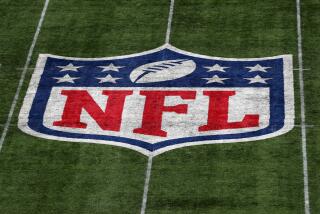NFL STRIKE : 1982 : A History Lesson Not Learned
- Share via
The strike to end all strikes, it wasn’t. No picketing. No violence. Not one raw chicken leg flung.
But what the National Football League walkout and lockout of 1982 lacked in classic labor drama, it more than made up in ill will and in-fighting.
For 57 days, as an NFL season wasted away, management and players stuck their tongues out at each other. The NFL Players Assn. demanded, among other things, that its members receive 55% of the league’s gross revenues. The owners told the players to take a hike. So they did, and didn’t return until seven regular-season games had been lost, to say nothing of $275 million in revenues and wages. The owners also were forced to return $50 million to the networks.
Nearly five years later, the owners and the NFLPA are at it again, only this time, say those who have played parts in both strikes, the circumstances and commitment aren’t entirely similar.
Back then, Ram running back Mike Guman was a third-year player from Penn State. Born in Allentown, Pa., a steel town rich in union tradition, and brought up in Bethlehem, Guman was raised on blue-collar rights. When a strike vote was taken shortly before the NFLPA agreement deadline, Sept. 20, 1982, Guman enthusiastically supported the union’s position.
“The last time, there was a feeling that everybody wanted to (strike), that we had to do it, that we have to get this thing done,” he said.
“Now it’s, ‘We’re doing it, but let’s get the thing settled as fast as we can.’ The atmosphere is definitely different than it was in ’82. The economic conditions are a little bit different.”
Ram safety Johnnie Johnson was another third-year player, somewhat confused with the issues but supportive, nonetheless.
“I had to look up at some of the older guys,” he said. “I knew what was on the table, but I didn’t understand all the benefits to the degree that I do today.
“Still, after ‘82, you felt like the last thing both sides would want is a strike. But yet, here we are, with no sign of an agreement.”
Some history is in order.
In 1982, the San Francisco 49ers began the year by defeating the Cincinnati Bengals in Super Bowl XVI and, in the process, helped CBS establish an all-time rating high for a sports event, although that mark has since been beaten. Shortly thereafter, the league agreed to a lucrative five-year contract with CBS, NBC and ABC that would begin, of course, with the 1982 exhibition season.
Meanwhile, the players’ association, led by Ed Garvey, a feisty, Washington-based lawyer, rallied his membership around the demand for 55% revenue sharing.
There were other concerns--the establishment of a minimum salary scale that guaranteed players certain pay depending on years of service; training camp and playoff pay increases; medical, insurance and retirement benefits; instituting a severance pay system that made easier a retiring player’s move from the NFL to another career; the chances of true free agency and the future of the league draft--but the call for 55% of the NFL’s gross revenues dominated the negotiations.
The owners refused, of course. Under Garvey’s plan, management would have had to relinquish $1.6 billion of its assorted gate receipts and television and radio money during the next four years to the players. To the 28 owners, that was unacceptable.
And thus began the constant posturing and rhetoric that became daily staples.
On it went until midnight, Sept. 20, when Garvey officially instructed union members to strike immediately after a Monday night game between the New York Giants and Green Bay Packers. Oddly enough, a similar order was issued Monday evening, again after a game at Giants Stadium in East Rutherford, N.J.
Owners responded with a lockout. Team fields, training rooms, weight rooms and equipment were declared off-limits to players. The NFL, for the moment, ceased to exist.
“In 1982, there were some bitter feelings on both sides,” said Ram defensive end Gary Jeter, then with the Giants. “We hadn’t seen the owners’ books and when we finally were able to see them, we were upset at the percentage (of revenue) we were receiving. It wasn’t fair.
“Guys were willing to sit out the whole season. We weren’t making any money. We were called professional ballplayers, but we weren’t being paid like professional ballplayers. There was no severance. We didn’t have as good a pension. Overall benefits weren’t as good.”
As for the demand of 55% of the revenue, Jeter credits Garvey for converting a sometimes divided and confused constituency.
“The 55% was etched in stone in 1982,” he said. “Sure, that was a strong stance. I don’t think one individual makes the union strong, but I think that Garvey did one great job on selling the membership on the 55%.”
Not everyone, however, was sold on the union’s strategy. Several prominent players, their reputations chock-full of marquee value, publicly questioned the NFLPA’s intentions. Among them, Danny White, quarterback of the Dallas Cowboys, who later attended periodic meetings with team General Manager Tex Schramm during the strike.
Even players who honored the 1982 strike, such as Cowboy defensive lineman Randy White, wondered about the wisdom of it all. “The longer the strike went on, the more I felt that this wasn’t the players’ strike, but Ed Garvey’s strike,” Randy White told the Dallas Morning News. “All we did was waste eight weeks of football.”
Garvey had become more than a centerpiece for union stances. He had become, in a sense, part of the negotiations.
“I felt like there was a point where the pride and ego did get involved in ‘82,” Johnson said of Garvey and management representatives. “At the time, I really didn’t understand the issues and everything. We went out with the general consensus that it wouldn’t last very long and it ended up lasting seven weeks.”
Said Doug Allen, a member of the NFLPA staff in 1982 and now the organization’s assistant executive director: “I think what characterizes the mood now as compared to ’82 is that there is a quiet strength and confidence as opposed to the hysteria that we had then.
“In ‘82, we had a very vocal minority of players that were adamantly opposed to what we were doing. And some of them were very highly visible and got a lot of attention. So we wasted a lot of energy and emotion internally in the majority trying to deal with the minority. We don’t have that problem now.
“I think (management) made Ed’s personality an issue, hoping that they could use that as an obstacle to settle. Certainly, Ed did a real great job for this union and he kept it alive through some very dark years when, short of a superhuman effort, we wouldn’t have a union. I think if he were still here, he would be doing some things differently this time, in order to show that personalities aren’t the problem.”
At strike’s beginning, players did their best to adhere to a practice schedule at local fields. But as the strike grew older, player attendance and perhaps interest decreased. Some players returned to their hometowns, others went on vacations.
Jeter, his leg in a cast because of leg surgery the day before the strike was announced, watched soap operas. “Those seven weeks were probably the worst of my life,” he said.
Said Ram safety Nolan Cromwell: “A terrible situation. The players lost a lot of money. The owners lost a lot of money.”
Not surprisingly, said Ram player representative Carl Ekern, who also served as the team’s spokesman in 1982, the strike ended quickly once NFLPA and management negotiators began discussing issues rather than wasting time on peripheral concerns. “Once they sat down, they got the whole thing done in four days,” Ekern said, who still has unused picket signs from the ’82 strike.
When it was over, when a collective bargaining agreement had been ratified and the players had received a 5-year, $1.28-billion package plus incentives, a 9-game schedule was salvaged. The season resumed Nov. 21 and ended with the Washington Redskins defeating the Miami Dolphins in something called the Super Bowl Tournament.
William Clay Ford, owner of the Detroit Lions, later described the entire affair as “a Mickey Mouse playoff system and an asterisk season.”
And what was learned?
Apparently nothing, Allen said.
“We’ve done so many things differently and it hasn’t made any difference,” he said.
WHAT IT WILL COST PLAYERS PER GAME
AROUND THE LEAGUE
Player Team Pos. Money Jim Kelly Buf QB $68,750 Joe Montana SF QB 62,500 John Elway Den QB 62,500 Lawrence Taylor NYG LB 56,250 Neil Lomax StL QB 54,688 Raymond Clayborn NE DB 51,563 Bernie Kosar Cle QB 50,000 Steve Largent Sea WR 48,125 Dan Fouts SD QB 46,875 Hugh Green Mia LB 46,875 Kellen Winslow SD TE 46,563 Mark Gastineau NYJ DL 45,313 Freeman McNeil NYJ RB 45,313 Dan Hampton Chi DL 45,313 Phil Simms NYG QB 43,750 Chip Banks SD LB 43,750
More to Read
Go beyond the scoreboard
Get the latest on L.A.'s teams in the daily Sports Report newsletter.
You may occasionally receive promotional content from the Los Angeles Times.










